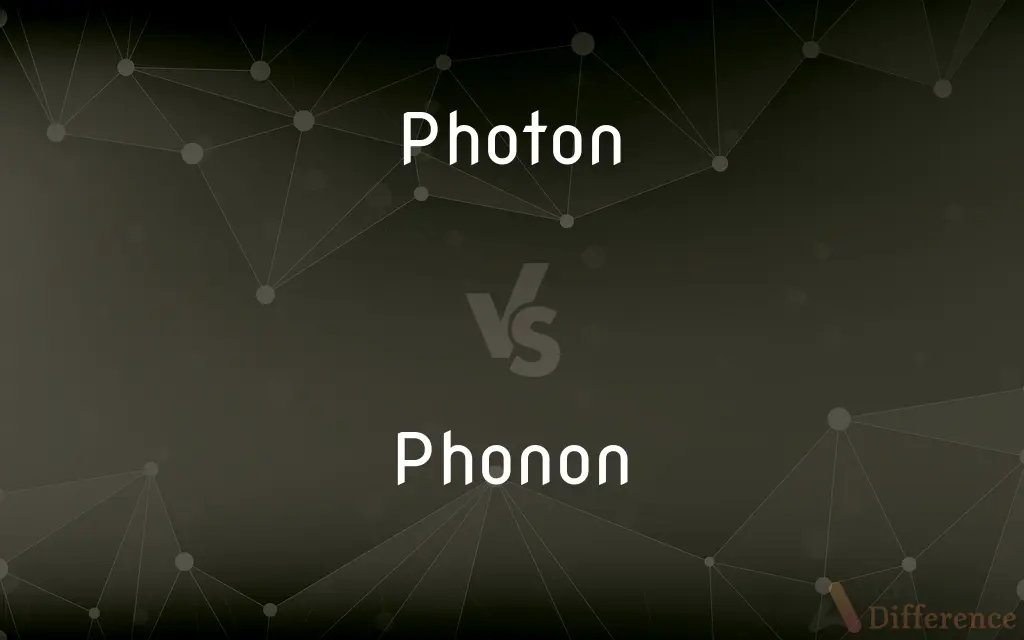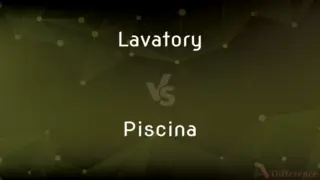Photon vs. Phonon — What's the Difference?
By Urooj Arif & Fiza Rafique — Updated on April 25, 2024
Photon refers to a particle of light, bearing energy but no rest mass, while a phonon represents a quantum of sound or vibrational energy in solids, crucial in thermal conductivity.

Difference Between Photon and Phonon
Table of Contents
ADVERTISEMENT
Key Differences
Photons are elementary particles that act as the basic units of light and all other forms of electromagnetic radiation, whereas phonons are quasiparticles indicating the quantum mechanical descriptions of vibrations within a lattice structure in crystalline solids.
Photons play a critical role in electromagnetic phenomena such as reflection, refraction, and transmission, while phonons are key to understanding thermal and elastic properties of materials.
Photons are massless and travel at the speed of light in a vacuum, on the other hand, phonons, being disturbances or vibrations in a material, do not move between materials but propagate at the speed of sound within the material.
Photons can be created and destroyed, for instance, in processes like emission and absorption of light, whereas phonons are generated or annihilated when the atoms in a solid vibrate from their equilibrium positions, often due to thermal energy.
Photons interact with charged particles, which is fundamental in phenomena like photoelectric effect and Compton scattering, whereas phonons interact with other phonons and defects within a solid, affecting its thermal conductivity and electrical properties.
ADVERTISEMENT
Comparison Chart
Nature
Quantum of electromagnetic radiation
Quantum of vibrational energy in solids
Mass
Massless
Not applicable (quasiparticle)
Speed
Speed of light in vacuum
Speed of sound within the material
Role in Physics
Carries electromagnetic force
Contributes to thermal and elastic properties
Interaction
With charged particles
With other phonons and defects in the solid
Compare with Definitions
Photon
A particle representing a quantum of light or other electromagnetic radiation.
A photon is emitted when an electron drops to a lower energy level.
Phonon
A quantized mode of vibration occurring in a rigid crystal lattice, representing the collective excitation in periodic structures.
Phonons play an essential role in the propagation of sound in solids.
Photon
The force carrier for the electromagnetic force, even when static via virtual photons.
The photons mediate electromagnetic forces between charged particles.
Phonon
Essential for understanding superconductivity and other phenomena.
Phonon interactions are crucial in the mechanism of superconductivity.
Photon
A massless particle that always travels at the speed of light in vacuum.
Photons from the sun travel at the speed of light to reach Earth.
Phonon
A quasiparticle resulting from the quantization of lattice vibrations.
Heat conductivity in diamonds is due to phonons.
Photon
An elementary particle with zero charge and spin one.
In quantum field theory, photons are described as gauge bosons with spin one.
Phonon
Can interact with electrons and influence electrical properties of materials.
In semiconductors, phonons can scatter electrons, affecting electrical conductivity.
Photon
A packet of energy determined by its frequency, according to Planck's relation E=hf.
Ultraviolet photons have more energy than infrared photons due to their higher frequency.
Phonon
Involved in thermal properties of solids and how heat is conducted through them.
Higher frequency phonons are more effective at transmitting heat.
Photon
The photon (Greek: φῶς, phōs, light) is a type of elementary particle. It is the quantum of the electromagnetic field including electromagnetic radiation such as light and radio waves, and the force carrier for the electromagnetic force.
Phonon
In physics, a phonon is a collective excitation in a periodic, elastic arrangement of atoms or molecules in condensed matter, specifically in solids and some liquids. Often referred to as a quasiparticle, it is an excited state in the quantum mechanical quantization of the modes of vibrations for elastic structures of interacting particles.
Photon
The elementary particle of light and other electromagnetic radiation; the quantum of electromagnetic energy. The photon is the massless, neutral vector boson that mediates electromagnetic interactions.
Phonon
The quantum of acoustic or vibrational energy, considered as a quasiparticle and used especially in mathematical models to calculate thermal and vibrational properties of solids.
Photon
(particle) The quantum of light and other electromagnetic energy, regarded as a discrete particle having zero rest mass, no electric charge, and an indefinitely long lifetime. It is a gauge boson.
Phonon
(physics) The quantum of acoustic or vibrational energy (sound), considered a discrete particle rather than a wave.
Photon
A quantum of electromagnetic radiation; an elementary particle that is its own antiparticle
Phonon
(linguistics) A unit of phonemics.
Common Curiosities
Can photons be absorbed or created?
Yes, photons can be absorbed or emitted by atoms during electronic transitions or other electromagnetic interactions.
Are phonons real particles like photons?
No, phonons are quasiparticles, which means they are not actual particles but represent collective excitations within a material.
What is a photon?
A photon is a quantum of electromagnetic radiation with no mass that travels at the speed of light and is responsible for carrying electromagnetic forces.
What are the practical applications of phonons?
Phonons are important in understanding and designing materials for heat management in electronics, acoustic insulators, and thermoelectric devices.
Why are photons important in quantum mechanics?
Photons are fundamental in quantum mechanics as they are carriers of quantum information and entanglement, central to the theories of quantum field and quantum optics.
Do photons have any mass?
Photons are massless particles; they do not have rest mass, which allows them to travel at the speed of light in a vacuum.
How do photons and phonons interact with matter?
Photons interact with charged particles, influencing phenomena like the photoelectric effect and radiative heat transfer, while phonons interact with other phonons and atomic imperfections, affecting thermal and electrical properties of solids.
What is a phonon?
A phonon is a quantum of vibrational energy in a crystal lattice that affects its thermal and acoustic properties.
How do photons and phonons differ in speed?
Photons travel at the speed of light, the maximum possible speed, while phonons propagate at the speed of sound within their respective materials.
What roles do photons play in technology?
Photons are crucial in technologies such as lasers, fiber optics communication, and solar cells, where their properties like wavelength and energy are exploited.
Can phonons be used to transmit information like photons?
While phonons are primarily involved in heat and sound transmission within materials, recent research explores using them for information transfer in quantum computing, although not as broadly as photons in optical communications.
How does the concept of phonons help in understanding superconductivity?
Phonons are crucial in the theory of superconductivity, particularly in how electron pairs (Cooper pairs) interact via phonons to create a state of zero electrical resistance.
How are phonons created in a solid?
Phonons are created when atoms in a solid vibrate from their equilibrium position, usually due to thermal energy, where these collective vibrations represent phonons.
Can the behavior of phonons affect electronic devices?
Yes, phonons can significantly affect the performance of electronic devices by influencing thermal conductivity and electron scattering, impacting device stability and efficiency.
Share Your Discovery

Previous Comparison
Slug vs. Bleed
Next Comparison
Lavatory vs. PiscinaAuthor Spotlight
Written by
Urooj ArifUrooj is a skilled content writer at Ask Difference, known for her exceptional ability to simplify complex topics into engaging and informative content. With a passion for research and a flair for clear, concise writing, she consistently delivers articles that resonate with our diverse audience.
Co-written by
Fiza RafiqueFiza Rafique is a skilled content writer at AskDifference.com, where she meticulously refines and enhances written pieces. Drawing from her vast editorial expertise, Fiza ensures clarity, accuracy, and precision in every article. Passionate about language, she continually seeks to elevate the quality of content for readers worldwide.















































